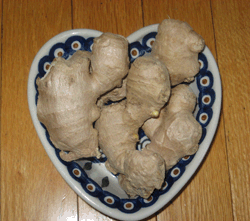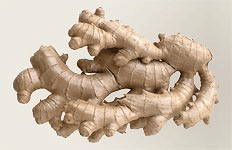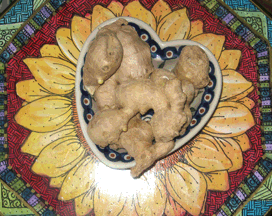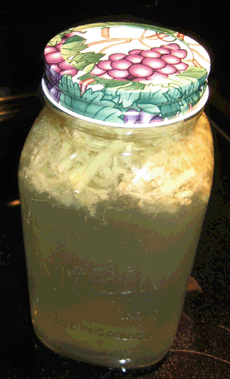 |
|||||
 |
 |
 |
 |
 |
 |
 |
Herb of the Season: Ginger |
||||
 Now that the garden is tucked under a couple feet of snow we should be indulging in our Wise Woman Ways to keep us healthy and vital throughout the winter months. We need to nourish ourselves through our food, drink and activity choices. Brew daily herbal infusions, make a pot of hearty soup to enjoy at any meal (especially breakfast according to Candis), go for a brisk walk, dressed warmly in lots of layers so you can enjoy the fresh air, even in the cold! One of my favourite herbs now making its way into my winter diet is pungent, warming ginger (zingiber officinale). I use it frequently in soups, curries, fruit compote and stir- fries but it’s also delicious dried, pickled, or as marmalade. I also add grated ginger to my winter infusions in an attempt to balance the cooling effect of herbs such as Nettle, Raspberry or Lemon Balm.  Zingiber may’ve been derived from the Sanskrit word shringavera meaning “shaped like a deer’s antler” which describes it perfectly. This aromatic herb is referred to as a circulatory stimulant because it increases blood flow to the extremities which helps to keep fingers and toes warm in cold weather. Ginger is a cardio-tonic and well-known for its ability to support cardiovascular health which is further enhanced by an active lifestyle. Although shoveling isn’t much fun, think of it as free functional exercise, great for your muscular and cardio endurance! Then treat yourself to a XC ski, snowshoe or skate at the local park, followed by a hot cup of ginger tea.  Ginger is used world-wide for its positive effect on the digestive system. The rhizome (or root) is rich in protein-digesting enzymes and antioxidants. I add chopped ginger (and garlic) to Teriyaki sauce before marinating fish to act as both a tenderizer and digestive aid. Ginger’s carminative properties are calming and relaxing, which enhance functioning of the digestive system, especially after heavy meals. Think of serving ginger tea alone, or simmered with a teaspoon of fennel seed, after your holiday feast to decrease bloating and digestive discomfort. Deb Soule, herbalist and founder of Avena Botanicals, recommends starting the day with a cup of hot ginger tea and a squirt of lemon juice to stimulate agni, our digestive fire. Simply simmer two cups of boiling water with an inch of thinly sliced ginger for 10 minutes. Strain and serve. The better our digestive system functions, the more nutrients we’ll be able to extract from the foods we eat…all part of a holistic and health promoting cycle. Ginger is also great for quelling nausea. I keep crystallized ginger in our glove compartment in case of motion sickness. Studies comparing the effects of ginger vs. over-the-counter (OTC) remedies found that ginger reduced seasickness and post-operative nausea more effectively and without side effects. For morning sickness relief, women (without a history of miscarriage) can try chewing crystallized ginger about fifteen minutes before getting out of bed. To decrease the chance of food poisoning, travelers should eat ginger or ginger candy (Asian shops carry the most potent variety) and always enjoy the ginger pickles served with sushi!  Adding ginger to your diet may also relieve arthritic pain and inflammation. Ginger inhibits the production of inflammatory prostaglandins causing fewer arthritic symptoms. A couple years before his knee replacement, Guy snacked on crystallized or dried ginger, tried ginger capsules, ate ginger curries and drank ginger infusions to manage the inflammation and pain in his arthritic knee. He had tried pharmaceutical pain relievers and anti-inflammatories and he was concerned about the predictable, standard side-effects he was experiencing. He felt a daily dose of ginger, in whatever form, was as effective as the prescription drugs and he managed to put the surgery off a couple more years. Another athletic friend, who was taking OTC pain relievers daily, mixed her ginger infusion with cranberry juice to counter its warming effect. She still had to pop the occasional pain killer but the ginger provided enough relief on most days of her busy week. Hot ginger compresses applied externally can also gently promote circulation and heat up tired and stiff muscles decreasing pain and inflammation. Simmer several ounces of grated ginger in water for ten minutes and apply a compress, dipped in the hot ginger broth, on to sore joints, sprains or stiff muscles. Replace the cold compresses with a hot one every few minutes, for a total of about fifteen minutes. Placed over the pelvic area, ginger’s antispasmodic qualities also work wonders as a comforting compress for uterine and abdominal cramping.  In order to prevent catching colds and flus, while promoting good digestion and circulation, I’ve added ginger to Rosemary Gladstar’s pickled garlic recipe, which she loved. Fill a jar with chopped ginger and whole garlic cloves. Cover with a tamari-honey mixture (1/2-1/2) for at least six weeks and then eat the delicious pickles liberally throughout the winter months. You can also pickle the herbs in a vinegar-honey marinade if you prefer. In the event that you do catch a cold or the flu, remember to brew a jar of ginger tea to help relieve stuffy nose, sore throat or bronchial congestion. I can’t remember where I collected this recipe but it may serve you well and speed up your recovery: Boil 2 cups water with an inch of peeled grated ginger for five minutes. Add ½ tsp of cayenne and simmer another minute. Add 2 tablespoons lemon juice, a clove or two of mashed garlic and honey to taste. Strain and sip throughout the day. Most importantly, give yourself the rest and comfort your body is craving and take a break from the hectic pace of life. There are more than a hundred species of ginger identified in tropical and sub-tropical regions where ginger thrives in the warm, humid, wet weather. Most of the commercial ginger is grown in Jamaica, India, Africa, and China and is abundant in Asian markets, health food stores or in the fresh produce section of your local grocery store. While we in the north consider it a warming herb, ideal for winter months, ginger is often served as iced tea in hot climates to help the body adjust to heat and humidity. On your next southern vacation, or next summer in the garden, slice an inch or two of ginger into four cups of boiling water. Steep for about 15 minutes, strain and stir in a half cup of honey. Cool and add a squeeze of lemon juice. Pour it over ice and benefit from this refreshing beverage as you celebrate the heat! Wishing you renewed energy as we return to the season of abundance and light with warmest, gingery blessings for a winter solstice filled with delight! Monica |
|||||
 | |||||
|
Over the years I have been blessed with many inspirational teachers. I thank them for sharing their wisdom through their lectures, workshops, websites and books. For more information about GINGER and many other herbs, enjoy these insightful and informative resources. | |||||
| Pocket Guide to Ayurvedic Healing by Candis Cantin |
(Crossing Press, 1996) Click for website |
||||
| Herbal Healing for Women by Rosemary Gladstar |
(Fireside Press, 1993) Click for website |
||||
| The Herbalist Multimedia Alternative Health Series by David Hoffman |
(David Hoffman, 1994) Click for website | ||||
| A Woman's Book of Herbs by Deb Soule | (Citadel Press, 1995) Click for website |
||||

|
|||||
 ©2026 Monica Giacomin ©2026 Monica Giacomin |
|||||